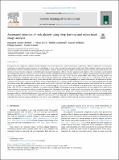Files in this item
Automated detection of rock glaciers using deep learning and object-based image analysis
Item metadata
| dc.contributor.author | Robson, Benjamin Aubrey | |
| dc.contributor.author | Bolch, Tobias | |
| dc.contributor.author | MacDonell, Shelley | |
| dc.contributor.author | Hölbling, Daniel | |
| dc.contributor.author | Rastner, Philipp | |
| dc.contributor.author | Schaffer, Nicole | |
| dc.date.accessioned | 2020-08-20T09:30:02Z | |
| dc.date.available | 2020-08-20T09:30:02Z | |
| dc.date.issued | 2020-12-01 | |
| dc.identifier | 269705140 | |
| dc.identifier | aebc1327-13e9-48d7-98f6-3f611b367ebe | |
| dc.identifier | 85089440785 | |
| dc.identifier | 000585306100006 | |
| dc.identifier.citation | Robson , B A , Bolch , T , MacDonell , S , Hölbling , D , Rastner , P & Schaffer , N 2020 , ' Automated detection of rock glaciers using deep learning and object-based image analysis ' , Remote Sensing of Environment , vol. 250 , 112033 . https://doi.org/10.1016/j.rse.2020.112033 | en |
| dc.identifier.issn | 0034-4257 | |
| dc.identifier.other | RIS: urn:76D8AB2613EDE05C224E2F3DCAFFDAB2 | |
| dc.identifier.other | ORCID: /0000-0002-8201-5059/work/79226958 | |
| dc.identifier.uri | https://hdl.handle.net/10023/20491 | |
| dc.description | B Robson was supported by the Meltzer foundation and a University of Bergen grant. S MacDonell was supported by CONICYT-Programa Regional (R16A10003) and the Coquimbo Regional Government via FIC-R(2016)BIP 40000343. D. Hölbling has been supported by the Austrian Science Fund through the project MORPH (Mapping, Monitoring and Modeling the Spatio-Temporal Dynamics of Land Surface Morphology; FWF-P29461-N29). N Schaffer was financed by CONICYT-FONDECYT (3180417) and P Rastner by the ESA Dragon 4 programme (4000121469/17/I-NB). | en |
| dc.description.abstract | Rock glaciers are an important component of the cryosphere and are one of the most visible manifestations of permafrost. While the significance of rock glacier contribution to streamflow remains uncertain, the contribution is likely to be important for certain parts of the world. High-resolution remote sensing data has permitted the creation of rock glacier inventories for large regions. However, due to the spectral similarity between rock glaciers and the surrounding material, the creation of such inventories is typically conducted based on manual interpretation, which is both time consuming and subjective. Here, we present a novel method that combines deep learning (convolutional neural networks or CNNs) and object-based image analysis (OBIA) into one workflow based on freely available Sentinel-2 optical imagery (10 m spatial resolution), Sentinel-1 interferometric coherence data, and a digital elevation model (DEM). CNNs identify recurring patterns and textures and produce a prediction raster, or heatmap where each pixel indicates the probability that it belongs to a certain class (i.e. rock glacier) or not. By using OBIA we can segment the datasets and classify objects based on their heatmap value as well as morphological and spatial characteristics. We analysed two distinct catchments, the La Laguna catchment in the Chilean semi-arid Andes and the Poiqu catchment in the central Himalaya. In total, our method mapped 108 of the 120 rock glaciers across both catchments with a mean overestimation of 28%. Individual rock glacier polygons howevercontained false positives that are texturally similar, such as debris-flows, avalanche deposits, or fluvial material causing the user's accuracy to be moderate (63.9–68.9%) even if the producer's accuracy was higher (75.0–75.4%). We repeated our method on very-high-resolution Pléiades satellite imagery and a corresponding DEM (at 2 m resolution) for a subset of the Poiqu catchment to ascertain what difference image resolution makes. We found that working at a higher spatial resolution has little influence on the producer's accuracy (an increase of 1.0%), however the rock glaciers delineated were mapped with a greater user's accuracy (increase by 9.1% to 72.0%). By running all the processing within an object-based environment it was possible to both generate the deep learning heatmap and perform post-processing through image segmentation and object reshaping. Given the difficulties in differentiating rock glaciers using image spectra, deep learning combined with OBIA offers a promising method for automating the process of mapping rock glaciers over regional scales and lead to a reduction in the workload required in creating inventories. | |
| dc.format.extent | 13 | |
| dc.format.extent | 7054648 | |
| dc.language.iso | eng | |
| dc.relation.ispartof | Remote Sensing of Environment | en |
| dc.subject | G Geography (General) | en |
| dc.subject | DAS | en |
| dc.subject.lcc | G1 | en |
| dc.title | Automated detection of rock glaciers using deep learning and object-based image analysis | en |
| dc.type | Journal article | en |
| dc.contributor.institution | University of St Andrews. School of Geography & Sustainable Development | en |
| dc.contributor.institution | University of St Andrews. Bell-Edwards Geographic Data Institute | en |
| dc.contributor.institution | University of St Andrews. Environmental Change Research Group | en |
| dc.identifier.doi | https://doi.org/10.1016/j.rse.2020.112033 | |
| dc.description.status | Peer reviewed | en |
This item appears in the following Collection(s)
Items in the St Andrews Research Repository are protected by copyright, with all rights reserved, unless otherwise indicated.

